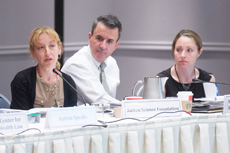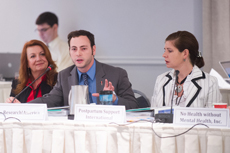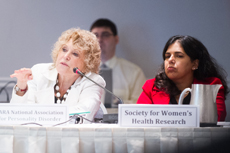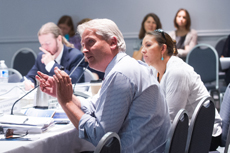Meeting Summary (Outreach)
Alliance for Research Progress — July 13, 2012 Meeting
July 13, 2012
Washington, DC
OVERVIEW
This document provides an overview of the proceedings of the seventeenth meeting of the National Institute of Mental Health’s (NIMH) Alliance for Research Progress (Alliance) on Friday, July 13, 2012 in Washington, DC. At Alliance meetings, participants hear about mental health and mental illness research, network with colleagues, and interact directly with NIMH director, Thomas Insel, M.D., and senior NIMH staff. Leaders from national organizations representing people whose lives have been directly affected by mental illness hear about major projects and activities currently ongoing at the National Institutes of Health (NIH) and NIMH. At this meeting, there were presentations and lively discussion about research advances and “citizen science,” data-sharing, and how advocacy groups can become part of the scientific process. Presentations and discussions centered on: information on the NIH Neurobiobank; the NIMH Research Domain Criteria (RDoC) project; the new resource at the Society for Neuroscience (SfN), BrainFacts.org; amazing advances in brain imagery; and progress in induced pluripotent stem cell (iPSC) research. Alliance members also provided comments on a concept clearance presented by NIMH staff entitled Genomic Risk and Resilience in 22q11 Deletion Syndrome: A Window into the Genetic Architecture of Mental Disorders. For more information on the speakers, please see the attached agenda and participant list.
MAJOR THEMES
State of the NIMH
Dr. Insel organized his talk around the NIMH Strategic Plan, telling Alliance members that completing the NIMH mission—to transform the understanding and treatment of mental illnesses through basic and clinical research, paving the way for prevention, recovery and cure—will require understanding gathered from fundamental science at many levels: molecular, cellular, social systems, as well as at the level of the individual. There have been extraordinary breakthroughs at every one of these levels.
At the molecular level, Dr. Insel noted that genomics research is our most powerful tool for understanding the vast amount of variation that exists between individuals. He mentioned that sequencing costs have dropped, from $10,000 per megabase of DNA sequence in 2001, to roughly .07 cents today, and that sequencing can be done in several places—not only government and academic laboratories. One of the biggest lessons learned from genomics research is that a “genetic” disorder or illness does not necessarily mean that the disorder is “inherited,” as spontaneous mutations are common. Genetics may reveal pathways involved in risk and resilience, and can provide a mechanism for experience to influence brain and behavior. An Alliance member commented that increasing the public’s understanding about genetic risk helps to reduce stigma, as parents realize they are not responsible for their child’s illness.
At the cellular level, research on iPSCs made from patients with mental illnesses have revolutionized our understanding of the trajectory of development, and research on these cells, which are unique to the individual, present the ultimate opportunity for personalized treatment. Dr. Insel explained to Alliance members how optogenetic tools are transforming technology at the systems level. With these precise, high-caliber visualization tools, scientists can view how individual connections change with development or treatment. Further, the Human Microbiome Project is revealing variation at the individual/whole person level. In this regard, Dr. Insel explained that each person is colonized with thousands of microbial species, involving trillions of organisms, and 90% of an individual is made up of microbes. The use of genomic tools in the attempt to better understand the microbome allows for intriguing investigation into the role of microbes in mental illnesses. Dr. Insel went on to discuss “crowd-sourcing”: how to utilize intellectual power of the community to solve problems. He stated that involving the public more broadly, by allowing every patient to become a partner in research through registries and other technological resources, will help to harness the power of big data to transform medical discovery.
With regard to what is limiting progress and application, Dr. Insel said that there is not a deep understanding of the biology of normal and abnormal brain development, function, and aging; the existing diagnostics are not precise; and therapeutics are not targeted. He also discussed the importance of language, telling Alliance members that “…language counts” when describing brain diseases, diagnosis, and treatments in the clinical setting and with the general public. Dr. Insel highlighted progress being made toward understanding schizophrenia. He mentioned the economic benefits of NIMH research, telling Alliance members how the Centers for Medicare and Medicaid Services and private insurers are intrigued at the prospect of reducing health care costs by using the NIMH model, because it reduces re-hospitalization, the largest source of cost increases. The North American Prodrome Longitudinal Study (NAPLS) study carries this further toward preempting the course, building resilience through brain plasticity by using computer games to improve executive function. He also mentioned that NIMH is looking for biomarkers that would enable prediction and pre-emption of the illness far earlier in its development.
NIH Neurobiobank Project Update
Roger Little, Ph.D., Senior Advisor for Science Coordination, Office of Science Policy, Planning, and Communications, NIMH talked about the importance of tissue donation for research. He said it is crucial to heighten public awareness of tissue donation and increase the availability of tissue for research, increase quality control, and standardize measures of tissue quality. He provided an update on the NIH Neurobiobank project, a federated brain and tissue banking system with an integrated information technology system. Dr. Little shared a draft brochure about the Neurobiobank and asked for comments. Alliance members were encouraged to share their members’ experiences with tissue donation and any best practices.
Advocacy, Registries, Biobanks and More
Sharon Terry, President and CEO, the Genetic Alliance, shared her personal experience with “citizen science.” She told Alliance members that her children were diagnosed with an extremely rare genetic disease, pseudoxanthoma elasticum (PXE). In response to the lack of information on the disease, she developed a biobank. Together with her husband, Ms. Terry worked with scientists to discover and patent the gene in 2000. PXE thus has the distinction of being the only disease for which a layperson is the inventor of the gene responsible for the condition. Now collaborating with the Genetic Alliance (http://www.geneticalliance.org/External Link: Please review our disclaimer.), a network of more than 1200 disease-specific organizations founded in 1986, she heads an advocacy-owned and managed repository of data and biological samples. She told the Alliance that it is time to convert “subjects” to participants who are full partners in research. She asked for support, technological solutions, and leadership in data sharing, and called for science to “live truth and openness,” abolishing behaviors that further competitive silos. Alliance members noted that her achievements and presentation reinforce the importance of creating a modern Framingham study for mental illnesses. Dr. Insel said that in the 21st century, the Internet has become the community for the collection of data worldwide. He also reminded Alliance members about Jamie Heywood’s presentation on the PatientsLikeMe registry at the last meeting of the Alliance. Ms. Terry closed by saying that open registries and biobanks tend to generate natural history studies, allowing the patient to influence science.
NIMH Research Domain Criteria (RDoC) Progress and Approach
The NIMH Director of the Division of Adult Translational Research and Treatment Development, Bruce Cuthbert, Ph.D., talked to the Alliance about RDoC. Noting the upcoming release of the fifth edition of the Diagnostic and Statistical Manual of Mental Disorders (DSM-5), Dr. Cuthbert stated that the current diagnostic system is based on a shared cultural understanding of mental illness that is 100 – 2000 years old, and which is defined by clusters of signs and symptoms useful for diagnosis at a time of limited knowledge in genetics, neuroscience, and behavioral science. Dr. Cuthbert noted that there is great variety in the presentation of symptoms of disorders; a single disorder involves many mechanisms; and each mechanism cuts across many disorders, thereby resulting in considerable heterogeneity and co-occurrence. He quoted former NIMH Director Steven Hyman, M.D., who said, “How can you develop a biomarker for something that doesn’t exist?” While the DSM is clinically useful, NIMH is developing a different approach toward diagnosis for research purposes. Dr. Cuthbert referred to the NIMH Strategic Plan, noting that Goal 1.4 calls for NIMH “to develop, for research purposes, new ways of classifying disorders based on dimensions of observable behavior and neurobiological measures.” RDoC is a framework to study mechanisms and circuits that cut across traditional disorders. Dr. Cuthbert emphasized that RDoC applies to clinical research only, and not basic research. Alliance members said that multiple diagnoses across time are common for their constituents, and more precise diagnosis is clearly needed. Members also noted that researchers and clinicians often object to a change in diagnostic criteria due to concern that their findings will be invalidated. In response to these comments, Dr. Insel said that this is not a competition, but rather that we are working to inform the future of nosology.
The Facts about BrainFacts.org
Debra Speert, Ph.D., Acting Director, Public Information and Outreach, SfN, reported on a newly launched resource, BrainFacts.org. She told Alliance members that there are 42,000 scientists who are members of SfN—including the next generation of the workforce—and getting them interested in mental illness is an important goal. Sponsored with funding from the Kavli Foundation and the Gatsby Charitable Foundation, with seven content partners, including NIMH, this online resource seeks to be the premier source of trusted information about the brain. There are already 1000 resources arranged topically and by audience on the website. The objectives of the Brainfacts.org effort are to: communicate to the public the importance of brain research; humanize scientists; and, share the value and successes of animal research. In closing, she encouraged Alliance members to contact her to ensure information relevant to their constituents is included.
Connectome: Advances in Brain Imagery
Bruce Rosen, M.D., Ph.D., Professor of Radiology, Harvard Medical School; Director, Athinoula A. Martinos Center for Biomedical Imaging, Department of Radiology, Massachusetts General Hospital spoke to the Alliance about the ambitious effort to map the neural pathways that underlie human brain function. To begin, Dr. Rosen quoted Dr. Insel’s statement that despite the publication of 4000 papers, “not a single finding has changed routine clinical care in psychiatry,” as well as his prediction that advances in understanding brain circuitry would change clinical care. Dr. Rosen explained that the Human Connectome Project allows studies of several different living, developing, and adapting brains; and promises to reveal individual differences in wiring that may be markers for vulnerability or resilience. Dr. Rosen showed Alliance members very detailed images of the brain, and said that they could see areas that communicate/fluctuate together and signal synchronization between areas of the brain. Connectome research has also shown that short- and long-term connectivity is reduced in schizophrenia, and delusion predicts connectivity deficits. He also highlighted the project’s achievement related to the discovery of a pervasive grid structure connecting circuits. Dr. Rosen called the Connectome a great observatory, similar to the Collider or Hubble Telescope.
“But when you think about the challenge of the universe, I would maintain it's really no greater than the challenge of trying to understand the most complicated piece of that universe that we know, which is our brain,” Dr. Rosen said. He told Alliance members that as a result of continued research, scientists are now hypothesizing abnormal synchrony in the face-processing network as a biomarker in autism; entire journals are devoted to connectivity; and, he predicts that specific diagnosis brain disorders is on the horizon. When asked by Alliance members if it is possible to see the difference in a diagnosable person versus one with symptoms, Dr. Rosen said that it is not yet possible. Other Alliance members inquired about diffusion imaging of brains before and after treatment, suggesting that it should be possible to see white matter changes, and change in response to psychotherapy or medications: “The brain is very, very plastic and stays that way for a long time. It would be nice to figure out ways to enhance that and kind of nudge it in the right direction,” the member said.
Breakthroughs and Advances in Induced Pluripotent Stem Cell (iPSC) Research
At the last meeting of the Alliance, Dr. Insel heralded iPSC research as the transforming technology for mental disorders. “You can rerun development and you can do it in a dish,” Dr. Insel said to the Alliance in February. He asked David Panchision, Ph.D., in the Division of Neuroscience and Basic Behavioral Science, NIMH to tell Alliance members about progress in iPSC research. Dr. Panchision stated that in mental illness, the absence of an obvious brain lesion to manipulate and correct has stymied mental health research, but stem cell research and cell reprogramming have the potential to be game changers. If it becomes possible to identify the molecular and cellular bases of diseases, that information can be used to modify drug targets and test potential therapies. Dr. Panchision explained that iPSCs are very similar to embryonic stem cells in that that they are pluripotent, but different in that they can be made from any adult cell, usually skin cells. In addition he noted that iPSCs can be patient-specific when the patient is the cell donor, as tissues derived from iPSCs will be a nearly identical match to the cell donor – thus reducing the probably of rejection by the immune system.
Dr. Panchision described NIH efforts in supporting 27 funded studies with cell lines from 600 subjects and a central repository to bank, and guidelines to validate and distribute iPSCs and source cells. The success of this approach rests on some admittedly high-risk assumptions about the causal abnormality: (1) that it is intrinsic to individual cells and is present and retained in the specific cells being isolated and manipulated; and (2) it can be resolved using assays that reconstitute some molecular, cellular, circuit, or developmental process (preferably a targetable, druggable process) that is predictive of the systems-level pathophysiology. He explained that cells reliably recapitulate aspects of development that you cannot do in a person. There is a built-in control with cells coming from the same patient, making it a very powerful tool. Dr. Panchision also discussed a recent NIMH-sponsored a workshop that gathered participants from academia, industry, private organizations, and government from the U.S., Europe and Asia, to discuss technical advances and challenges, possible utility for target identification, screening and drug development, and growth areas for a pre-competitive consortium.
DISCUSSION
During the discussion periods, Alliance members had the opportunity to direct comments and questions to the NIMH Director, and to engage the presenters in lively dialogue. Dr. Insel answered many questions and comments, and other inquiries were directed to the other speakers. Dr. Insel was asked to provide an analysis of the NIMH portfolio to help Alliance members communicate about the different funding categories. Dr. Insel reminded them about the NIH RePORTER resource. Alliance members also expressed concern about the prospect of budgetary sequestration, which will begin January 2, 2013, unless Congress takes action. They called for concerted effort, stressing that it is critically urgent that Alliance members work together. Alliance members praised the meeting, saying how important it is for these stakeholder organizations to hear about cutting edge science, especially the knowledge that these “mental illnesses” are brain diseases, so that they may be true partners in the critical task of disseminating the science widely to students, providers, the general public, and especially to all those who are directly affected by mental illness.
PHOTOGRAPHS
View additional images from the meeting on the NIMH Flickr photo stream at http://www.flickr.com/photos/nimhgov/sets/72157631289784306External Link: Please review our disclaimer.

Alliance members listening to presentations

Alliance members sharing views

Alliance members commenting on presentations

NIMH Director, Thomas Insel, M.D.

Alliance members commenting on presentations

Alliance members sharing their views

Alliance members commenting on presentations

Invited speakers (L to R): Bruce Rosen, M.D., Ph.D., Roger Little, Ph.D., Sharon Terry, M.A., Thomas Insel, M.D., Bruce Cuthbert, Ph.D., David Panchision, Ph.D.
Meeting Information/Options
- Meeting Summary
- Participant List
- Agenda





